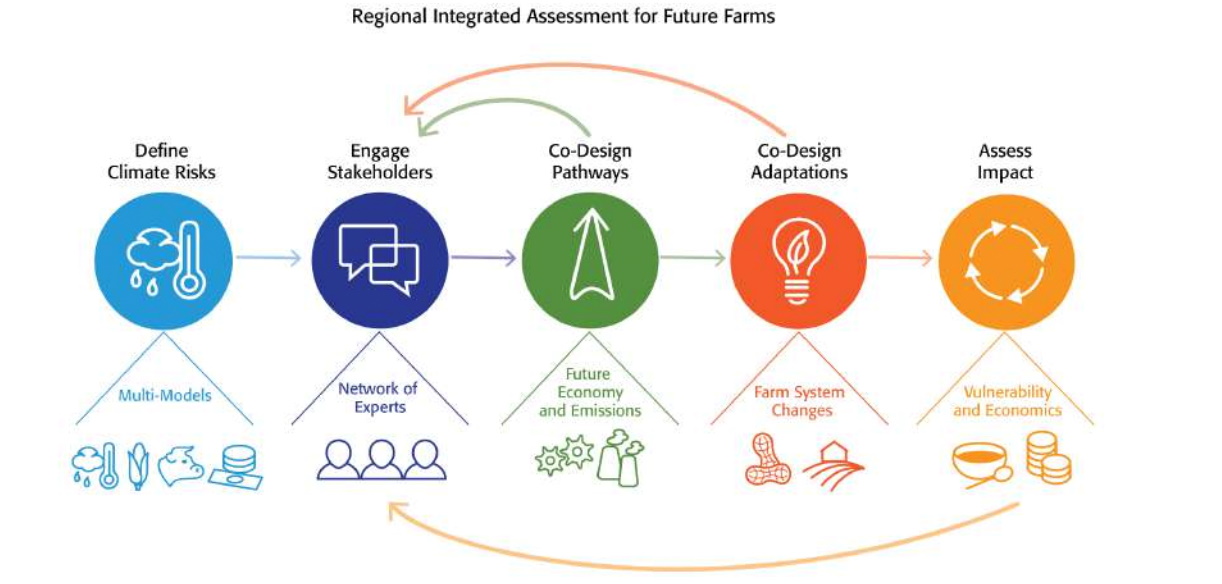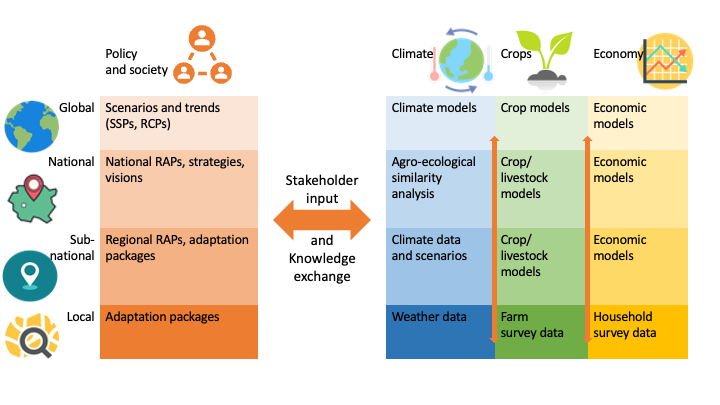Methodology
Methodology
The impacts of future climate change on farming systems are complex and uncertain. Policy-makers need actionable information in order to ensure future food security. They must be well informed of regional conditions and adaptation options so national policies will support local actions for improvement.
The Agricultural Model intercomparison and Improvement Project (AgMIP) is an international collaborative effort to improve agricultural modelling and to understand climate impacts on the agricultural sector at global, national, and regional scales.
The integrated assessments conducted in the regional and national studies connect information from climate, crop and economic model simulations, and knowledge from experts and stakeholders. They give insight in the vulnerability of these complex systems and test adaptations to improve farmers' livelihoods.
This section explains important elements of the AgMIP methodology.
Core research questions
AgMIP has identified four core research questions that guide research activities for regional integrated assessments. Each question is designed to allow comparison between two different production states: climate vulnerability in the current world, climate adaptation in the current world, climate vulnerability in the future world, and climate adaptation in the future world. The future period represents mid-century. Impact indicators may include crop and livestock yields, value of production, poverty, or net farm or household income.
In the AgMIP regional studies only the most relevant of these core questions are fully elaborated.
Current agricultural system
Future agricultural system
Science, policy and practice
In regional integrated assessments, climate change impacts on the agricultural system of a region are simulated. Stakeholders are involved to bring in knowledge to co-design pathways (RAPs, Representative Agricultural Pathways) and adaptation options (see next sections).

National impact assessments are based on data, modelling results, formal procedures and expert judgment on agricultural production systems and future changes, for all regions of a country.
In the CLARE project, extensive stakeholder interviews and surveys were conducted to analyze national climate change planning for agriculture in Ghana, Senegal and Zimbabwe. The results of this analysis will guide future AgMIP studies and support policymakers in applying scientific knowledge in policy development.
Integrated assessments and scientific models
Integrated assessments
The AgMIP integrated assessments apply scientific models and stakeholder expertise to estimate effects of climate change on crops and food security. This is an elaborate process: scientific models must simulate very complex real-life processes and require extensive sets of reliable input data. Different kinds of expertise (from science and practice) are necessary to validate, correct, fine-tune, and interpret the results.

Toward National and Regional Integrated Assessment Protocols
The principal goals of National and Regional Integrated Assessment (NRIA) are to support a country’s ongoing National Adaptation Planning and related policy initiatives:
-
Analyze the country’s agricultural sector performance under alternative strategies to implement its national adaptation plan (NAP), using stakeholder-defined performance indicators; and
-
Complement and support regional integrated assessment (RIA) of agricultural system adaptation at the regional (sub-national) level by regional teams of stakeholders and scientists.
To achieve these two goals, NRIA begins with the identification of a set of scenarios to be modeled over a stakeholder-defined planning horizon. Each of these scenarios is comprised of two main components: a strategy for national adaptation plan implementation; and a future pathway comprised of projected future climate conditions (associated with Representative Concentration Pathways, or RCPs) and socio-economic conditions (represented by global Shared Socio-economic Pathways, SSPs, and national Representative Agricultural Pathways, RAPs).
NRIA uses quantitative modeling to evaluate the performance of the country’s agricultural sector and main agricultural systems for each scenario using stakeholder-defined performance indicators for each scenario. These indicators can be measures of agricultural productivity, prices, food consumption, etc.
A key methodological element of NRIA is the linkage of global and national models needed for national policy evaluation with the more detailed regional assessments needed to design and evaluate on-farm adaptations. A spreadsheet tool (National-Regional Interface) was developed for this purpose.

Scientific models
Difference in climate models
Historical climate data
Climate scenarios
Climate scenarios are plausible representations of future climate conditions (temperature, precipitation, and other aspects of climate such as extreme events).
We cannot precisely predict the way that society, industry, and technology will develop in the coming decades, and thus we cannot precisely predict the amount of greenhouse gas emissions that will drive climate change (such as carbon dioxide, CO2). Scientists therefore use climate models to project different scenarios of greenhouse gas levels in the atmosphere. These show the regional temperature and rainfall impacts that affect agriculture and food security.
Climate scenarios for the AgMIP National Integrated Assessments
How were climate scenarios generated?
RAPs (Representative Agricultural Pathways)
Resilience to shocks, enablers and obstacles
RAPs help to understand the drivers and obstacles that affect transition of a farming system.
The ba ll-and-cup heuristic illustrates the process. The ball represents a system, for instance, a farm or farming system in a specific state. The cup‐shaped landscape represents possible states a system can be in.
ll-and-cup heuristic illustrates the process. The ball represents a system, for instance, a farm or farming system in a specific state. The cup‐shaped landscape represents possible states a system can be in.
A system (the ball) can be pushed beyond a threshold to another state. State (a) has steeper walls and a deeper cup than (c). It is more difficult to move out of state (a). The desired direction is forward (to the right) and upwards.
A ball may be stuck in an undesirable state, for instance a low level of productivity and adaptation. The institutions and policies may not provide sufficient structure for the ball to move upwards to a more desirable state.
Shocks and disturbances, such as climate effects, may ”push” the system out of the cup. A deep cup, strong institutions and enabling policies, prevents the ball from dropping back and better prepares it to continue moving up.
The differences between the expected policies and institutions in the RAPs, lead to different effects on the farming systems.
National and sub-national (regional) RAPsThe core of the national RAPs are the policy drivers at national level. These include the shared climate policy assumptions by which a country aims at supporting climate change mitigation and adaptation. |
RAPs: Representative Agricultural Pathways

Adaptation packages
Adaptation PackagesModelling outcomes and expert knowledge lead to adaptation options that are discussed with stakeholders. The resulting range of solutions are the Adaptation Packages. They describe cultivar, management, and agricultural sector policies specifically designed to increase production and resilience as climate changes. These are specific to each region and country and may be compared in the regional and national study pages in the Impacts Explorer. |












